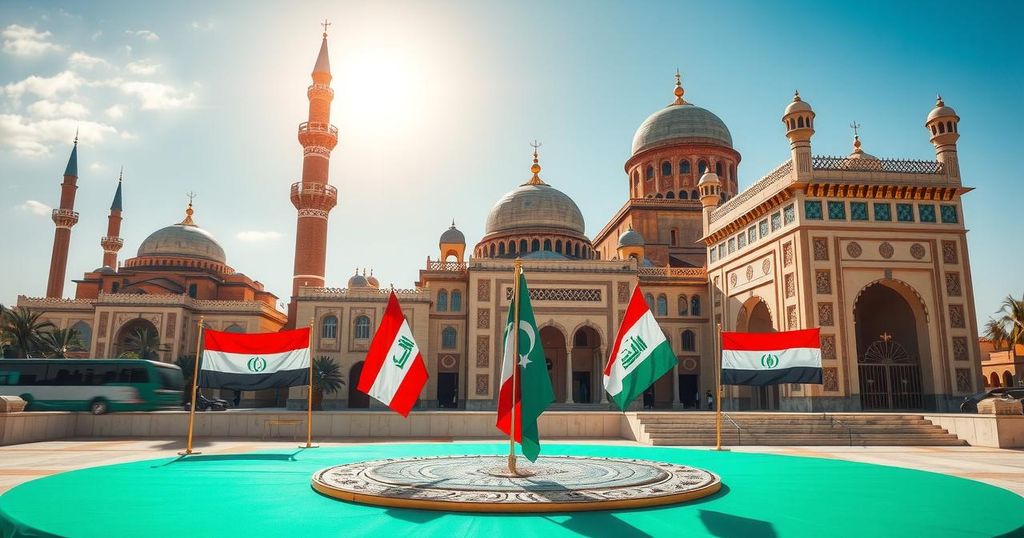Key Moments From Trump’s Middle East Diplomacy Tour
President Trump has concluded a significant tour of the Middle East, visiting Saudi Arabia, Qatar, and the UAE. The highlights included a $142 billion arms deal with Saudi Arabia, plans to lift sanctions on Syria, and talks of a potential nuclear agreement with Iran amid ongoing discussions on Gaza. The trip showcased Trump’s bold diplomatic maneuvers and set the stage for future U.S. engagement in the region.
President Donald Trump has concluded a high-profile three-nation tour of the Middle East, marking a significant shift in U.S. relations with the region. His itinerary included pivotal investment agreements, a historic face-to-face meeting with the Syrian President—his first in 25 years—and discussions on a potential nuclear deal with Iran that may alter the geopolitical landscape entirely.
Trump began his journey in Riyadh, Saudi Arabia on May 13, where he received a lavish welcome at the Royal Saudi Palace. During his visit, he inked multi-billion dollar agreements spanning various industries, including a tremendous $142 billion arms deal with the Saudi government. The White House later claimed that total investments signed during his visit exceeded $600 billion.
The President proceeded to Doha, Qatar on May 14, where yet another round of agreements was sealed, highlighted by a colossal $96 billion contract with Boeing. During a roundtable with business leaders, Trump raised eyebrows with his controversial idea of the United States taking control of the Gaza Strip, a notion that has drawn widespread criticism globally.
For the final leg of his tour, Trump traveled to the United Arab Emirates on May 15. Here, he signed an agreement on artificial intelligence valued at approximately $1.4 trillion. Reflecting on the whirlwind trip, Trump expressed concerns that future leaders may take credit for his initiatives. “Somebody’s going to be taking the credit for this. You remember, press, this guy did it,” he remarked during the flight back to Washington, D.C.
In Saudi Arabia, the initial highlight was of course the $142 billion arms deal. Crown Prince Mohammed bin Salman personally welcomed Trump, who was joined by notable figures like Tesla CEO Elon Musk. Agreements were not just limited to arms; security, intelligence cooperation, and energy deals were also signed during his visit, illustrating a comprehensive strategy towards bolstering ties.
A surprise announcement came from Trump at the U.S.-Saudi Investment Forum, where he said he intends to lift decades-old sanctions on Syria, which he described as “brutal and crippling.” However, experts like Benjamin Feve from Karam Shaar Advisory caution that this plan is complex and must navigate numerous bureaucratic hurdles.
Trump met with Syrian President Ahmed al-Sharaa, who has a checkered past with U.S. intelligence. This meeting, briefed by the Saudi Crown Prince and attended remotely by Turkish President Erdogan, was unexpected and raised eyebrows. Trump praised al-Sharaa, calling him a “tough guy” with a strong chance to stabilize Syria post-Assad.
Before the tour’s commencement, Trump faced backlash for his plan to accept a luxury Boeing gift valued at $400 million from Qatar. Critics, including Democratic Senator Ed Markey, were vocal regarding security concerns, dubbing it a potential threat. However, the President responded defiantly, asserting: “Only a FOOL would not accept this gift on behalf of our country.”
Significantly absent from the tour itinerary was Israel, yet the ongoing Israel-Hamas conflict remained a topic. Trump reiterated his belief in establishing a U.S. presence in Gaza during discussions in Doha, describing the region as a potential “freedom zone”—an idea many leaders have condemned.
Moreover, Trump’s discussions regarding Iran suggested potential thawing relations, unlike during his previous term when he exited the nuclear agreement. According to Iranian advisor Ali Shamkhani, Iran might be willing to sign a nuclear deal with specific conditions, including halting its nuclear ambitions in exchange for the lifting of sanctions.
As President Trump departed the region, optimism seemed to linger over the negotiations, although disagreements regarding uranium enrichment still pose red flags. In his closing remarks to reporters, Trump issued a warning to Iran about the urgency for a favorable agreement: “They know they have to move quickly, or something bad is going to happen,” he warned.
In wrapping up his extensive Middle East tour, President Trump has initiated crucial dialogues and potential agreements that could reshape U.S. relations with key Middle Eastern nations. From arms deals in Saudi Arabia to addressing sanctions on Syria and addressing the contentious Gaza situation, his visit encapsulated a whirlwind of diplomatic overtures. Regardless of the lingering challenges, including Iran’s nuclear ambitions and ethical dilemmas regarding foreign gifts, the tour certainly reaffirmed Trump’s commitment to reorienting American foreign policy in the region.
Original Source: time.com




Post Comment